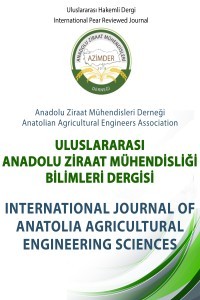Comparison of Local Sesame (S. indicum L.) Genotypes for Yield and Some Yield Components
Sesame, local genotype, seed yield
___
- Arslan H, Hatipoglu H,Karakus M, 2014. Şanlıurfa Yöresinde Tarımı Yapılan Susam Genotiplerinden Seçilen Bazı Hatların İkinci Ürün Koşullarında Verim ve Verim Unsurlarının Belirlenmesi. Turk J Agric Res, 1: 109-116. (in Turkish).
- Bahkali AH, Hussain MA,Basahy AY, 1998. Protein and oil composition of sesame seeds (Sesamumindicum, L.) grown in the Gizan area of Saudi Arabia. International Journal of Food Sciences and Nutrition, 49: 409-414.
- Baydar H, 2005. Susamda verim, yağ, oleic ve linoleik tipi hatların tarımsal ve teknolojik özellikleri. Akdeniz Üniversitesi Ziraat Fakültesi Dergisi, 18(2): 267-272. (in Turkish).
- Baydar H, Erbaş S, 2014. Yağ Bitkileri Bilimi ve Teknolojisi. Süleyman Demirel Üniversitesi Ziraat Fakültesi, Yayın No: 97, 227-248. (in Turkish).
- Caliskan S, Arslan M, Arioglu H, Isler N, 2004. Effect of planting method and planting populations on growth and yield of sesame in a Mediterranean type of environment. Asian Journal of Plant Sciences, 3(5): 610-613.
- Daniya E, Dadari SA, Ndahi WB, Kuchinda NC, Babaji BA, 2013. Correlation and Path Analysis between Seed Yield and some Weed and Quantitative Components in Two Sesame (Sesamumindicum L.) Varieties as influenced by Seed Rate and Nitrogen Fertilizer. Journal of Biology, Agriculture and Healthcare, 3(15): 12-16.
- El-NakhlawyFS,Shaheen MA, 2009. Response of Seed Yield, Yield Components and Oil Content to the Sesame Cultivar and Nitrogen Fertilizer Rate Diversity.Env.& Arid Land Agric. Sci., 20(2): 21-31.
- El-Sherif AMA, 2016.Sesame (Sesamumindicum L.) Yield and Yield Components Influenced by Nitrogen and Foliar Micronutrient Applications in the Fayoum Region, Egypt. Egypt. J. Agron. 38 (3): 355-367.
- Jamie SD, Langham DR,Wongyai W, 2002. Potential selection criteria for the development of high – yielding determinate sesame varieties. Sesame and Safflower News,17: 29-35.
- Kashani H, Shahab-u-Din, KandhroM N, Ahmed N, Saeed Z, Nadeem A, 2016. Seed Yield and Oil Content of Sesame (Sesamumindicum L.)Genotypes in Response to Different Methods of Nitrogen Application.Indian Journal of Science and Technology, 9(30), DOI: 10.17485.
- KilliF,Tekeli F, 2016. Seed yield and some yield components of sunflower (Helianthus annuusL.) genotypes in Kahramanmaras (Turkey) conditions. Journal of Scientific and Engineering Research,3(4):346-349
- Misganaw M, MekbibF,Wakjira A, 2015. Genotype x environment interaction on sesame (Sesamumindicum L.) seed yield. African Journal of Agricultural Research, 10 (21): 2226-2239.
- Öz M, Karasu A, 2010. Bazısusamçeşitvehatlarının Bursa koşullarında performanslarının belirlenmesi.J. Agric. Fac. HR. U., 14(2): 21-27. (in Turkish).
- Paroda RS, 2013. The Indian oilseeds scenario: Challenges and opportunities. Journal of Oilseeds Research, 30 (2): 11-126.
- SaxenaK,Bisen R, 2017. Line x Tester Analysis in Sesame (Sesamumindicum L.). International Journal of Current Microbiology and Applied Sciences, 6(7): 1735-1744.
- Siva PYVN, Krishna MSR,Yadavalli V, 2013. Correlation, path analysis and genetic variability for economical characteristics in F2 and F3 generations of the cross AVT 3 × TC 25 in Sesame (S.indicum L.).J. Environ. Appl. Biores,1(2): 14-18.
- Tan AŞ, 2011. Bazı Susam Çeşitlerinin Menemen Koşullarında Performansları. Anadolu J. of AARI, 21 (2): 11 – 28. (in Turkish).
- Uzun B, Yol E, Furat S, Topakci M, Canakci M, Karayel D, 2012. The effects of different tillage methods on the post-wheat second crop sesame: seed yield, energy budget, and economic return. Turk J Agric For, 36: 399-407.
- Yol E, Karaman E, Furat Ş, Uzun B, 2010.Assessment of selection criteria in sesame by using correlation coefficients, path and factor analyses. Aust J Crop Sci, 4: 598-602.
- ISSN: 2667-7571
- Başlangıç: 2019
- Yayıncı: Anadolu Ziraat Mühendisleri Derneği
Yield - Efficiency Indicator Production Products
Dmitrii PARMACLİ, Serghei KARA
Ordu Yöresinde Yetişen Kızılcıkların (Cornus mas L.) Seleksiyon Yoluyla Islahı Üzerine Araştırmalar
Comparison of Local Sesame (S. indicum L.) Genotypes for Yield and Some Yield Components
The Role Of Agriculture in The Economi of The Republic of Moldova and Gagauzia
